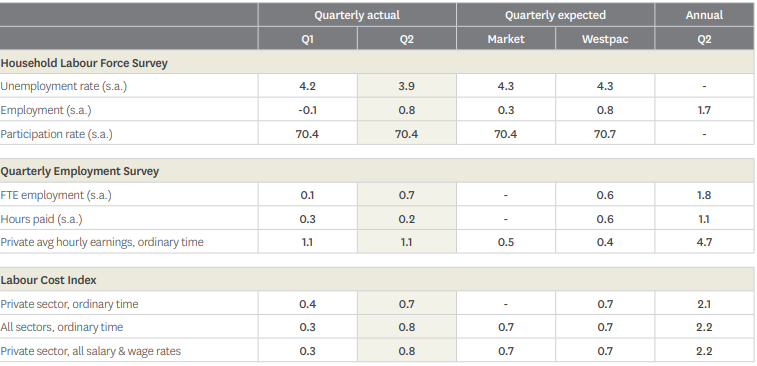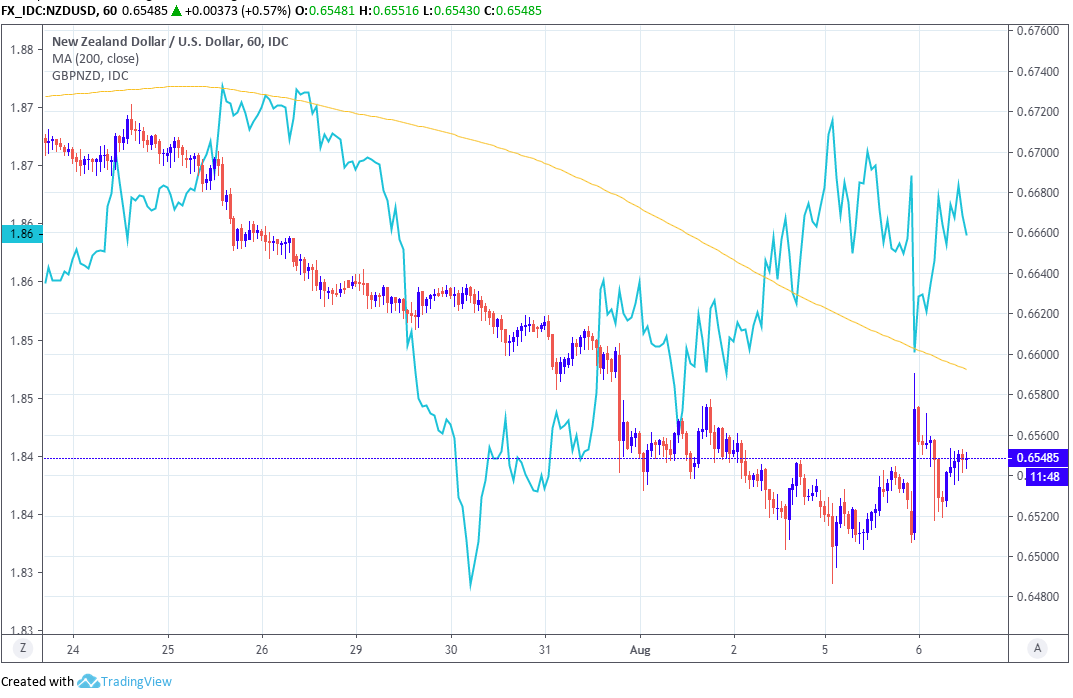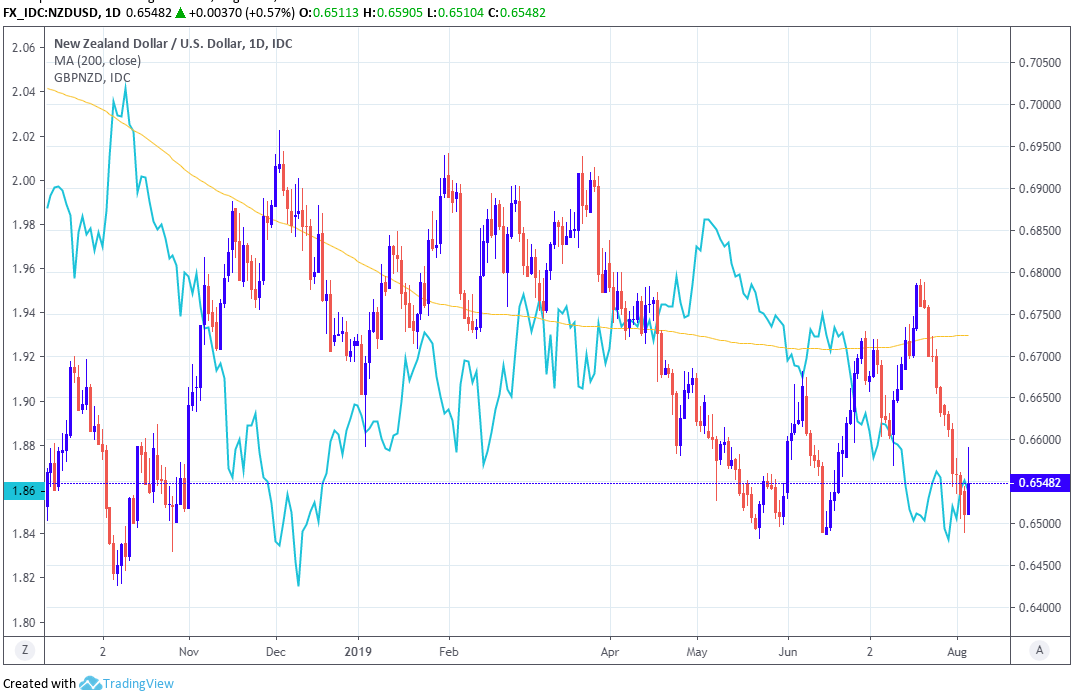The New Zealand Dollar Fades as RBNZ Dominates, Jobs Data Falls by Wayside
- Written by: James Skinner

© Natanael Ginting, Adobe Stock
- NZD boosted overnight by strong Q2 jobs and wages growth.
- But gains fade as RBNZ rate cut and guidance looms large.
- RBNZ seen cutting to 1.25% Wednesday, warning of more.
- As U.S.-China trade war augurs fears for economic outlook.
- J.P. Morgan, ING Group, both tip fresh NZD losses this month.
The New Zealand Dollar softened Tuesday even after the latest jobs figures showed the labour market in rude health during the second quarter, with traders overlooking the data in light of an imminent interest rate decision from the Reserve Bank of New Zealand (RBNZ).
New Zealand's economy saw employment rise 0.8% in the recent quarter, more than reversing a revised contraction of 0.1% from the first-quarter, which was enough to push the unemployment rate down from 4.2% to an 11-year low of 3.9%. Markets had looked for employment to rise only 0.3% and for an increased jobless rate of 4.3%.
Wage growth also picked up notably in the second quarter, aided by an increase in the minimum wage, which is positive for the inflation outlook and will doubtless be welcomed by the RBNZ in the early hours of Wednesday morning.
"The measures of wage growth were inevitably affected by the 7.3% minimum wage hike that took effect in April. The Labour Cost Index (LCI) rose by 0.7% overall, in line with our forecasts, although the 0.8% rise in private sector wage rates was a little stronger than we forecast," says Micahel Gordon at Westpac. "Today’s surveys will give the Reserve Bank some comfort around how it’s performing against its ‘maximum sustainable employment’ mandate."

Above: NZ employment statistics for second-quarter 2019. Source; Westpac.
Tuesday's data will be welcomed by the RBNZ because a robust labour market is a prerequisite for further wage growth, which is itself necessary for the bank to be confident it can sustainably achieve the inflation target of a 2% average over the medium term. Inflation rose from 1.4% to 1.7% in the recent quarter.
The RBNZ has long had to contend with below-target inflation and has this year resorted to cutting its interest rate in the hope that stimulating the economy with lower borrowing costs will produce the additional economic demand that it needs for price pressures to rise.
Consensus is for the RBNZ to cut its cash rate by 25 basis points for a second time this year on Wednesday at 03:00 London time, which will take New Zealand's benchmark of borrowing costs down to a new record low of 1.25%. It was 1.75% before the bank cut it back in May.
"We still think a cut is all but assured, along with a bias towards further easing. The stronger than expected labour market figures make it less likely that the RBNZ will immediately follow up with a cut in September, although global developments might still force its hand," says Westpac's Gordon.
Changes in rates are normally only made in response to movements in inflation, which is sensitive to growth, but impact currencies because of the push and pull influence they have over capital flows. Those flows tend to move in the direction of the most advantageous or improving returns, with a threat of lower rates normally seeing investors driven out of and deterred away from a currency.

Above: NZD/USD at hourly intervals alongside Pound-to-New-Zealand-Dollar rate (blue line, left axis).
"Given markets expectations, we do not necessarily see a weaker-NZD reaction right after the rate announcement but expect the forward guidance to confirm that the outlook will continue to be unsupportive for the currency," says Francesco Pesole, a strategist at ING.
The New Zealand Dollar has been hurt badly over the last eighteen months as financial markets began betting long ago that the RBNZ would be forced to cut its cash rate deeply in order to revive a still-weak inflation pulse. The Kiwi is down 2.4% against the U.S. Dollar this year and has fallen against many other major currencies, although the antipodean unit has risen against 2.17% against a Brexit-battered Pound Sterling.
Financial markets have fully priced-in a total of two more RBNZ interest rate cuts for 2019, which should mean the bank can cut Kiwi borrowing costs twice without further harming the currency. In addition, pricing in the overnight-index-swap market shows investors flirting with the idea of betting on another cut coming inside the first quarter of 2020, which is important for the Kiwi.
"We expect trade tensions to start abating in 4Q19 as both China and the US move closer to a trade deal. This would likely drain up the downward pressure on NZD, but we expect - differently from AUD – weaker economic fundamentals to make the recovery in NZD/USD quite lengthy and suspect the pair may need to wait until 2Q20 to climb back above 0.6600," Pesole says.
The ebb and flow of expectations for policy changes this year and in early 2020 will be an important influence on the New Zealand currency over the coming months, although those expectations will evolve in response to developments on the ground as well as those on more distant shores.
Some analysts say the May and August escalations of the U.S. trade war with China point to that international picture developing in a way will augur further losses for the Kiwi Dollar. President Donald Trump has threatened to impose fresh tariffs on some Chinese exports to the U.S. in order to heap pressure on the country in trade talks.

Above: NZD/USD at daily intervals alongside Pound-to-New-Zealand-Dollar rate (blue line, left axis).
"Both AUD and NZD tend to be laggards in the month of August, and given the current risk and central bank environment, seem poised to deliver another month of antipodean underperformance (exhibit 2). For these reasons, we increase our high beta exposure by layering in a new NZD/USD short in cash to capitalize on both an underwhelming local story along with the defensive risk environment," says Meera Chandan, an analyst at J.P. Morgan.
New Zealand has a significant agricultural commodity trade with China, which means the Kiwi is sensitive to all things related to the world's second largest economy, its currency and commodity prices. China's remaining $300 bn of annual exports to the U.S. will be hit with a 10% tariff from September 01, while the rest of its exports are weighed down with a 25% levy.
China has now been declared a "currency manipulator" by the U.S. after the People's Bank of China (PBOC) allowed the Renminbi to weaken after the tariff announcement, further raising tensions between the two countries and leading markets to speculate about the odds of a 'currency war'. China didn't meet the criteria to be designated a manipulator in April and still doesn't, but that didn't prevent the U.S. from pushing ahead with it this week.
"We could be dealing with an overshooting countertrend decline only, as long as 0.6575/74 (last low/weekly trend) is defended. A break below the latter, though, would only leave the 2018 low at 0.6424 in the way to potentially still prevent a re-test of the 2015 low at 0.6236," says Thomas Anthonj, a technical analyst at J.P. Morgan.
Time to move your money? Get 3-5% more currency than your bank would offer by using the services of foreign exchange specialists at RationalFX. A specialist broker can deliver you an exchange rate closer to the real market rate, thereby saving you substantial quantities of currency. Find out more here.
* Advertisement




